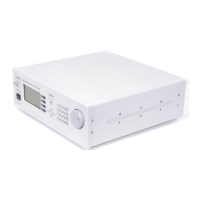62 Chapter 4 Temperature Controller Module Operation
4.5.2.4.2 Two Point Calibration Method
The calibration described in this section is independent of the calibration procedure
described in sections 6.3.4 and 6.3.6. Those sections deal with the internal calibration
of the 8300 module, while the following calibration procedure is for calibrating the
external AD590 or LM335 sensor. For the most accurate possible results, both
calibration procedures should be performed.
The accuracy of this procedure depends on the accuracy of the externally measured
temperature. It is used to determine the zero offset of the device and the gain (slope).
1. Allow the 8000 to warm up for at least one hour. Select the desired
sensor type in the setup menu.
2. Set the C1 parameter to zero. Set the C2 parameter to 1.
3. Place the sensor at an accurately known and stable temperature, T
a1
.
Connect the sensor to the 8000 for normal Constant temperature
operation. Allow the 8000 to stabilize at the known temperature, T
a1
and read the displayed temperature, T
d1
. Record these values.
4. Repeat Step 3 for another known temperature, T
a2
, and the
corresponding displayed temperature, T
d2
. The two known temperatures
should at the bounds of the intended operating range. For best results,
make the range between T
a1
and T
a2
as narrow as possible.
5. Determine the new value of C1 and C2 from the following calculations.
First determine the intermediate values U and V, where
C2 = (T
a1
- T
a2
) / (T
d1
- T
d2
), and
C1 = T
a1
- (T
d1
* C2)
6. Enter the new C1 and C2 values.
4.5.3 RTD Sensors
RTD sensors are not supported on dual or combination TECs.
The following equation is used in temperature to resistance conversions:
R
t
= R
0
[1 + C1 x t - C2 x t
2
- C3 (t-100) t
3
) for t < 0°C
R
t
= R
0
[1 + C1 x t - C2 x t
2
) for t >= 0°C
where: R
t
is the resistance in Ω at temperature t.
Artisan Technology Group - Quality Instrumentation ... Guaranteed | (888) 88-SOURCE | www.artisantg.com

